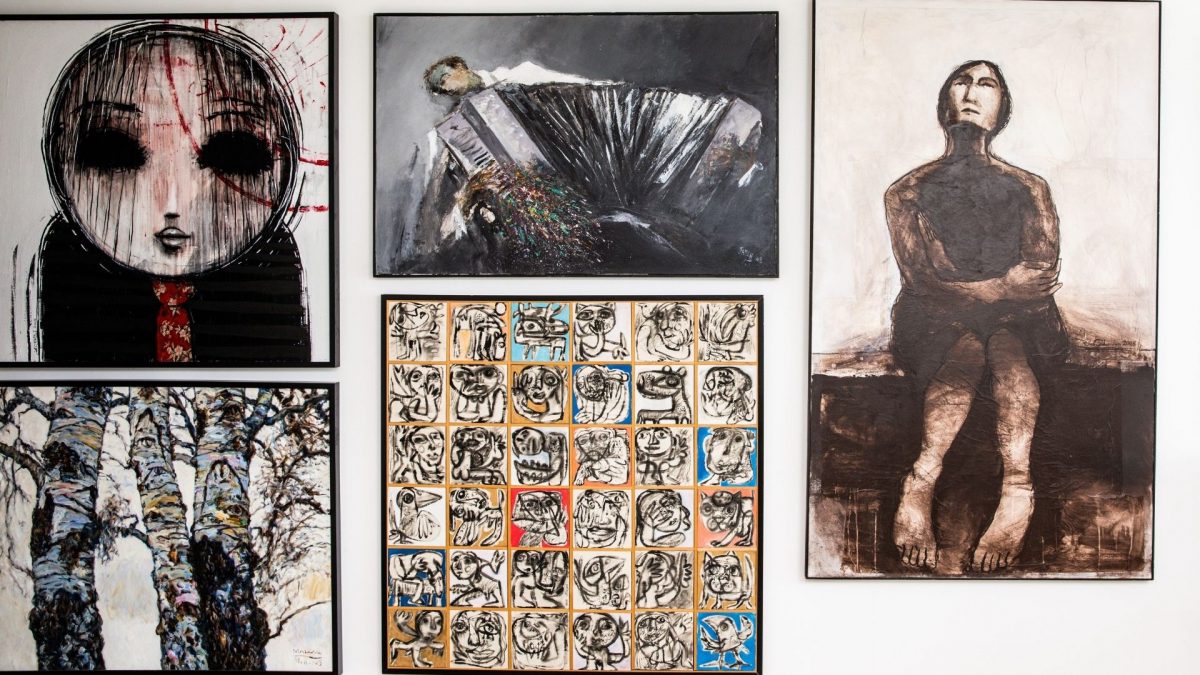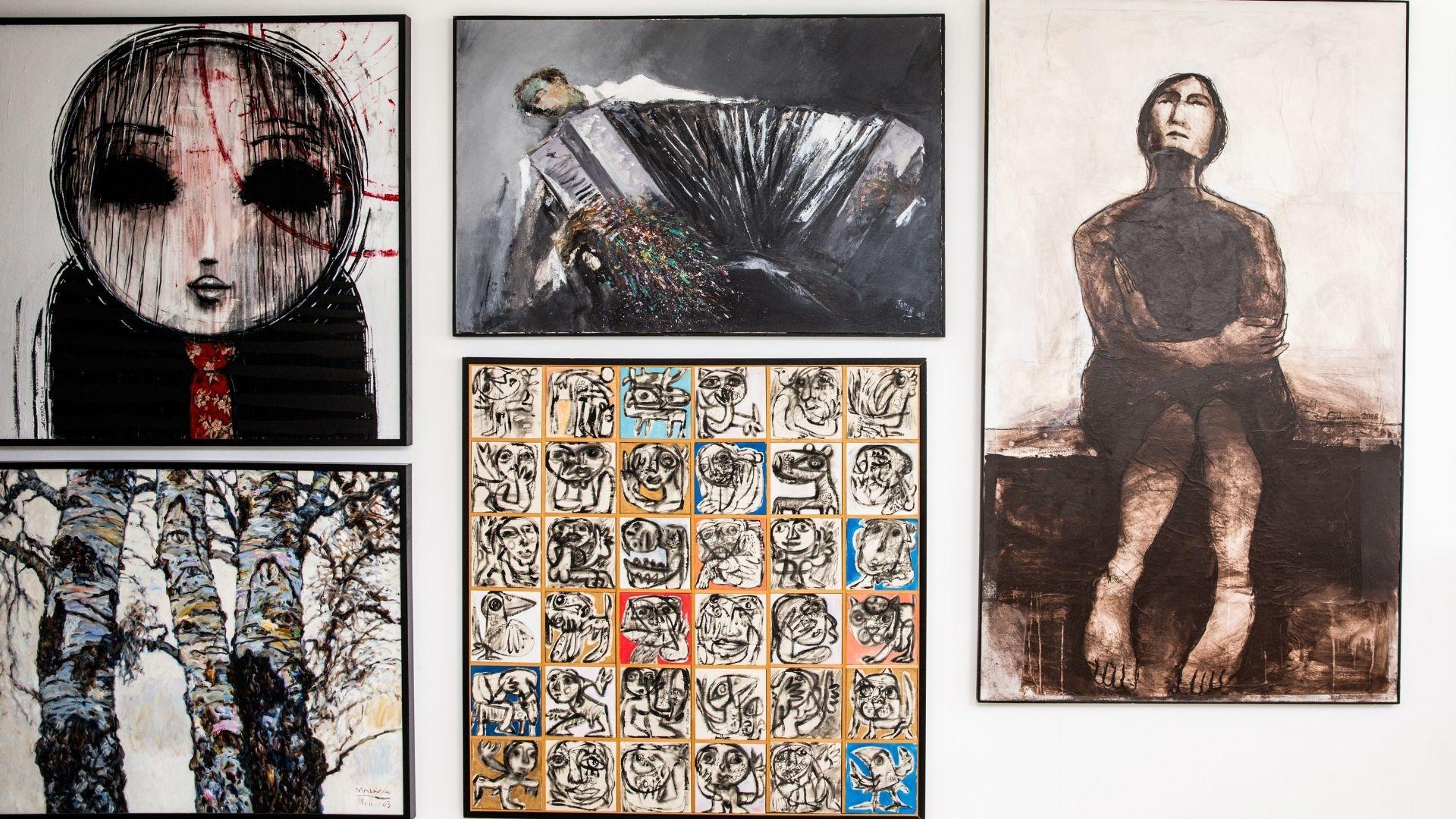
Zina Khair On Mastering An Art Collection
Born into a family of art aficionados, founder of fashion brand Le Marais 101 and avid collector Zina Khair welcomes
BAZAAR Art into her Dubai home, which resembles a Syrian art gallery with works dating back to the 80s
Born in Damascus, Zina Khair was raised within a Syrian home of art collectors: her mother, an artist herself, and her father, an art enthusiast, passed down their creative genes to their three daughters, namely Thala, Zina and Aya, who have all mastered artistry within each of their professions. Zina is the founder of Dubai-based fashion brand Le Marais 101, which specialises in recreating pre-owned items such as handbags and accessories.
If you were to ask her to describe her childhood home in Damascus, “I would vividly remember the Fateh Moudarres paintings that filled our walls from floor to ceiling,” she smiles. Why Moudarres of all artists? As Zina’s father once wrote, I don’t know, his work struck me. The countryside, the women, the artefacts, the materials he used. He was a very interesting character who combined art, philosophy, poetry and music.
Before the launch of Atassi Gallery in 1986, Damascus was almost devoid of an established art scene. Then, the launch of Ayyam Gallery, Tajalliyat Art Gallery and the Art House supported the flourishing art scene in the city, paving the way for later artinstitutions and events to take centre stage.
Witnessing the contemporary art movements in Syria coupled with her family’s love for art, Zina found herself naturally drawn to the field. A great admirer of the late Syrian painter Fateh Moudarres, Zina’s father, Munzer Khair, wrote a book entitled The Khair Art collection: Fateh Moudarres, which was edited by Art Dubai’s new Regional Director, Hala khayat.
The publication coincided with an exhibition organised by Ayyam Gallery and Christie’s in 2018, where 83 artworks by Moudarres from Zina’s personal family collection were unveiled. These works were later showcased in 2019 at the International Council at MoMA. Naturally, the first work Zina ever purchased was a painting by Moudarres.
“I remember I was working and saving money because I had spotted this beautiful painting called The Twins (1989) and I was hoping that it wouldn’t be sold before I was able to pay for it,” she recalls. “Thankfully, the gallerist was a good friend and accepted to let me pay by instalments and have it.”

Zina Khair stands in her art-filled entryway
Alongside Moudarres, modern and contemporary works by an array of Syrian artists hang in Zina’s art-filled Dubai home in DIFC, including Louay Kayali, Mohannad Orabi, Marwan Kassab-Bachi, Safwan Dahoul, Nazir Shora, Nazir Nabaa, Youssef Abdelke, Sabhan Adam, Asaad Orabi, Omar “Malva” Hamdi, Fadi Yazji and Michel Kersheh.
A work of note is a portrait from the Khair Art Collection, depicting Zina’s parents painted by Moudarres in 1974 with an inscription by the artist. When it comes to collecting art, Zina highlights that one must understand the difference between collecting and investing.
“When you first buy an artwork, it is either because of a coup de foudre or because you believe it is a good investment,” she expresses. “Collecting comes at a later stage when you start making decisions based on how much you love the artwork, but most importantly, on how much it adds to your collection. You even reach a level where you start looking for an artwork to complete your collection.”
Personally, Zina has withheld from buying a painting she has fallen in love with on several counts, simply because she found it wiser to invest in another work which would add more value to her collection. “I have to admit that what first started as an entirely passion-driven act, over the years turned into a more calculated and studied one.”
 Assad Arabi. Old Damascus. 2008; A work by Serwan Baran. 2010
Assad Arabi. Old Damascus. 2008; A work by Serwan Baran. 2010
When Zina’s family first moved to Dubai in 2012 after the war erupted in their hometown, torn, Zina admittedly struggled to settle into her new home. “We stayed two and a half years in a furnished apartment and I refused to hang a single painting on the wall because to me, Damascus was where I left my soul,” she sighs.
Displaying the very first painting on the wall marked the Dubai house’s transition into a ‘home’. “To me the idea of home doesn’t exist without art,” she says. “A home is soulless without art.” “With so many galleries shifting into the digital realm, what are your thoughts on collecting art online?” I ask.
“Had you asked me this question before March 2020, my answer would have probably been different,” Zina admits. “Today, we are waking up to a new reality where we are slowly accepting the fact that things as we knew them have changed forever. The sooner we adapt, the sooner we can recreate a new form of normalcy. I guess that we will have to accept the fact that the experience of art-buying, where it only makes sense if you’re actually able to feel the artwork, will soon no longer exist and will be replaced by feeling it though our screens.
Today I find this sad, but I don’t think that my children and grandchildren will see it in the same way. In the past few months, we have learned that everything is possible and that as humans, we are able to adapt to literally anything.”

 A 2010 work by Assaad Yagan; Below, clockwise from left: Works by Mohannad Orabi. 2008; Jaber Alwan. 2008; Rima Salamon. 2008; Fadi Yazigi. 2006; Omar (Malva) Hamdi. 2003
A 2010 work by Assaad Yagan; Below, clockwise from left: Works by Mohannad Orabi. 2008; Jaber Alwan. 2008; Rima Salamon. 2008; Fadi Yazigi. 2006; Omar (Malva) Hamdi. 2003
Zina leaves us with some invaluable advice on building and mastering an art collection, noting that research and personal interest are both crucial when doing so.
“Look for artists, themes, techniques that entice you. Learn as much as you can about that initially – there is really no road map to this,” she asserts. “Don’t pay attention to trends. Just follow your heart.”
Image Courtesy of Zina Khair
From the Autumn 2020 Issue of Harper’s Bazaar
